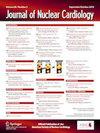Automatic motion correction for myocardial blood flow estimation improves diagnostic performance for coronary artery disease in 18F-flurpiridaz positron emission tomography-myocardial perfusion imaging
IF 3
4区 医学
Q2 CARDIAC & CARDIOVASCULAR SYSTEMS
引用次数: 0
Abstract
Background
Motion correction (MC) is critical for accurate quantification of myocardial blood flow (MBF) and flow reserve (MFR) from 18F-flurpiridaz positron emission tomography (PET) myocardial perfusion imaging (MPI). However, manual correction is time consuming and introduces inter-observer variability. We aimed to validate an automatic MC algorithm for 18F-flurpiridaz PET-MPI in terms of diagnostic performance for predicting coronary artery disease (CAD).
Methods
In total, 231 patients who underwent invasive coronary angiography and rest/pharmacologic stress 18F-flurpiridaz PET-MPI from the phase III Flurpiridaz trial (NCT01347710) were enrolled. For manual MC, two operators (Reader 1 and Reader 2) shifted each frame's images in three directions. The automatic MC algorithm, initially developed for 82Rb-chloride PET-MPI, was optimized for 18F-flurpiridaz. Diagnostic performance was compared using minimal segmental MBF/MFR with and without MC to predict obstructive CAD by invasive coronary angiography.
Results
Manual MC took 10 minutes per case (both stress and rest) on average, while automatic MC required <10 seconds. The area under the receiver operating characteristic curves (AUCs) for significant CAD using minimal segmental MBF were comparable between automatic and manual MC (AUC = 0.877 automatic, AUC = 0.888 Reader 1 and AUC = 0.892 Reader 2; all P > 0.05). AUCs of minimal segmental MBF with manual and automatic MC were significantly higher than without MC (P < 0.05 for both). Similar findings were observed with minimal segmental MFR.
Conclusions
Automatic MC can be performed rapidly, with diagnostic performance for predicting obstructive CAD comparable to manual MC. This method could be utilized for analysis of MBF/MFR in patients undergoing 18F-flurpiridaz PET-MPI.

心肌血流估计的自动运动校正提高了 18F-flurpiridaz PET-MPI 对冠状动脉疾病的诊断性能。
背景:运动校正(MC)是 18F-flurpiridaz PET 心肌灌注成像(MPI)准确量化心肌血流(MBF)和血流储备(MFR)的关键。然而,手动校正不仅耗时,而且会造成观察者之间的差异。我们的目的是验证 18F-flurpiridaz PET-MPI 的自动 MC 算法在预测冠状动脉疾病(CAD)方面的诊断性能:共231名患者接受了有创冠状动脉造影术和静息/药物应激18F-氟匹利达PET-MPI检查,这些患者来自氟匹利达Ⅲ期试验(NCT01347710)。在手动 MC 算法中,两名操作员(阅读器 1 和阅读器 2)将每帧图像向三个方向移动。自动 MC 算法最初是为 82Rb 氯化物 PET-MPI 开发的,后针对 18F 氟匹利达进行了优化。使用最小节段 MBF/MFR(有 MC 和无 MC)比较了诊断性能,以通过血管造影预测血管狭窄≥70% 的 CAD:手动 MC 平均每例花费 10 分钟(包括压力和静息),而自动 MC 仅需 0.05 分钟。)使用手动和自动 MC 的最小节段 MBF 的 AUC 明显高于不使用 MC 的情况(p 结论:自动 MC 可以快速进行,并具有较高的成本效益:自动MC可快速进行,其预测阻塞性CAD的诊断性能与手动MC相当。这种方法可用于分析接受 18F-flurpiridaz PET-MPI 检查的患者的 MBF/MFR。
本文章由计算机程序翻译,如有差异,请以英文原文为准。
求助全文
约1分钟内获得全文
求助全文
来源期刊
CiteScore
5.30
自引率
20.80%
发文量
249
审稿时长
4-8 weeks
期刊介绍:
Journal of Nuclear Cardiology is the only journal in the world devoted to this dynamic and growing subspecialty. Physicians and technologists value the Journal not only for its peer-reviewed articles, but also for its timely discussions about the current and future role of nuclear cardiology. Original articles address all aspects of nuclear cardiology, including interpretation, diagnosis, imaging equipment, and use of radiopharmaceuticals. As the official publication of the American Society of Nuclear Cardiology, the Journal also brings readers the latest information emerging from the Society''s task forces and publishes guidelines and position papers as they are adopted.

 求助内容:
求助内容: 应助结果提醒方式:
应助结果提醒方式:


